Francesco del Cossa (c. 1435 – c. 1477/78) stands as one of the most compelling and individualistic painters of the Early Italian Renaissance, a pivotal figure in the Ferrarese School. His relatively short but intensely productive career left an indelible mark on the artistic landscape of Northern Italy, particularly in Ferrara and Bologna. Working alongside contemporaries such as Cosimo Tura and Ercole de' Roberti, Cossa helped define the distinctive style of Ferrara – a potent blend of courtly elegance, expressive intensity, and a meticulous attention to detail that often verged on the crystalline. His art, characterized by sculptural figures, complex linear rhythms, and a sophisticated understanding of perspective and light, reflects both the humanist currents of his time and a deeply personal vision.
Early Life and Artistic Formation in Ferrara
Born in Ferrara around 1435, Francesco del Cossa's early life and training are not extensively documented, a common challenge when studying artists of this period. His father, Cristoforo del Cossa, was also a painter, suggesting that Francesco likely received his initial artistic instruction within the family workshop. Ferrara, under the rule of the Este family, was a vibrant cultural center, attracting artists, poets, and scholars. This environment would have provided a stimulating backdrop for a young, ambitious painter.
The artistic milieu of Ferrara in the mid-15th century was already dynamic. Artists like Galasso Galassi and Michele Pannonio, of Hungarian origin, were active, and the influence of the International Gothic style was gradually giving way to the innovations of the Renaissance. However, the most significant early influences on Cossa are widely considered to be Andrea Mantegna and Piero della Francesca. Mantegna, active in nearby Padua and later Mantua, was renowned for his powerful, statuesque figures, his mastery of perspective, and his deep engagement with classical antiquity. Piero della Francesca, whose work Cossa may have encountered directly or through intermediaries, was a master of geometric clarity, serene monumentality, and the subtle rendering of light.
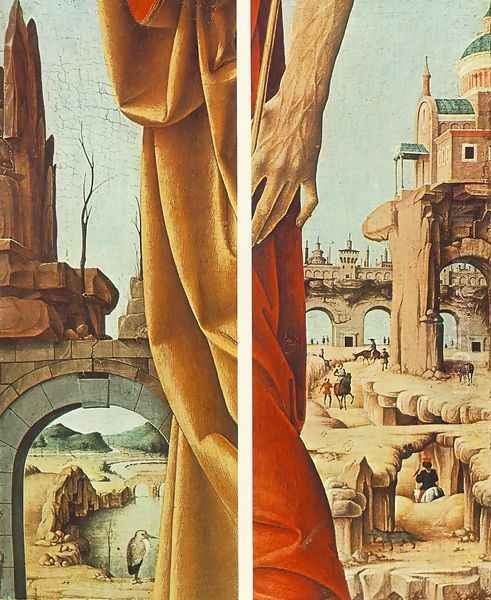
Cossa's early works demonstrate a synthesis of these influences, filtered through a distinctly Ferrarese sensibility. He absorbed Mantegna's interest in sculptural form and archaeological detail, but tempered it with a greater softness and a more animated, sometimes even quirky, expressiveness. From Piero, he learned the importance of light in defining form and creating atmosphere, yet his own use of light often had a sharper, more jewel-like quality. The Ferrarese School, as a whole, developed a unique style characterized by a certain nervous energy, intricate ornamentation, and figures that, while solid, often possessed an almost metallic sheen and sharp, expressive features.
The Palazzo Schifanoia: A Monumental Achievement
Francesco del Cossa’s most famous and arguably most significant contribution to art history is his work on the fresco cycle in the Salone dei Mesi (Hall of the Months) at the Palazzo Schifanoia in Ferrara. This grand project, commissioned by Borso d'Este, Duke of Ferrara, between 1469 and 1470, aimed to celebrate the Duke's benevolent rule and the harmonious order of his state through a complex allegorical program. The overall design is often attributed to Cosimo Tura, the leading painter in Ferrara at the time, but Cossa was responsible for executing some of the most memorable sections.
The Salone dei Mesi was conceived as an elaborate astrological and seasonal allegory. Each month was depicted in three horizontal bands. The uppermost band featured the triumph of the month's tutelary Olympian deity, accompanied by scenes related to their mythology. The middle band displayed the zodiac sign for the month and three enigmatic "decans" or sub-rulers. The lowest band depicted scenes from the daily life of Duke Borso d'Este and his court, showcasing his activities, acts of justice, and interactions with his subjects.
Cossa is credited with painting the frescoes for the months of March, April, and May on the east wall. These sections are particularly well-preserved and stand out for their vibrant color, lively compositions, and keen observation of detail. In the Allegory of March, Minerva, goddess of wisdom, presides in her triumphal chariot, surrounded by scholars and weavers. Below, Borso d'Este is shown administering justice and enjoying a hunt. The Allegory of April features Venus in her chariot drawn by swans, with scenes of lovers and the Three Graces. The lower register shows Borso returning from the hunt and participating in the Palio di San Giorgio. The Allegory of May is dominated by Apollo, god of music and poetry, with the Muses and scenes of agricultural labor.
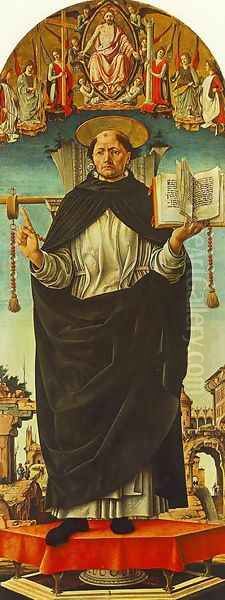
Cossa’s figures in these frescoes are robust and energetic, their draperies rendered with a characteristic crispness that defines underlying forms. He masterfully populates these complex scenes with a multitude of figures, animals, and architectural elements, all woven into a coherent and engaging narrative. The depiction of courtly life, with its rich costumes and leisurely pursuits, provides a fascinating glimpse into the world of the Este court. The attention to detail, from the textures of fabrics to the expressions on individual faces, is remarkable. His style here, while sharing some commonalities with Tura, exhibits a greater naturalism and a more relaxed, less "strained" quality than Tura's often more ascetic and intensely expressive figures.
Despite the brilliance of his contribution, Cossa felt undervalued. A famous letter from Cossa to Borso d'Este, dated March 25, 1470, reveals his dissatisfaction with the payment he received for his work on the Schifanoia frescoes. He complained that he was being paid by the square foot at the same rate as the "poorest dauber in Ferrara" and that he had borne the cost of materials like gold and ultramarine himself. He argued that his skill and diligence, particularly in the demanding fresco technique, deserved better remuneration, especially when compared to the other artists working on the project, implicitly including Tura. This dispute over payment is believed to be a primary reason for Cossa's departure from Ferrara.
The Move to Bologna and Flourishing of a Mature Style
Around 1470, disillusioned with his treatment in Ferrara, Francesco del Cossa relocated to Bologna. This city, with its ancient university and thriving artistic scene, offered new opportunities for patronage and recognition. In Bologna, Cossa's style continued to evolve, reaching a new level of maturity and refinement. He received several important commissions, primarily for altarpieces and other religious works.
One of his most significant Bolognese works is the Griffoni Altarpiece, painted for the Griffoni Chapel in the Basilica di San Petronio around 1473. Though now dismembered and its panels scattered across various museums, reconstructions suggest a monumental and cohesive work. The central panel, depicting St. Vincent Ferrer, is now in the National Gallery, London. This powerful figure, rendered with Cossa's characteristic sculptural solidity and intense gaze, showcases his ability to convey deep spiritual conviction. Other surviving fragments include a poignant Crucifixion (National Gallery of Art, Washington D.C.) and figures of St. Peter and St. John the Baptist (Pinacoteca di Brera, Milan). The altarpiece as a whole would have been a commanding presence, reflecting Cossa's mastery of composition and figural representation. Ercole de' Roberti, his younger Ferrarese compatriot, is believed to have assisted him on parts of this altarpiece, particularly the predella.
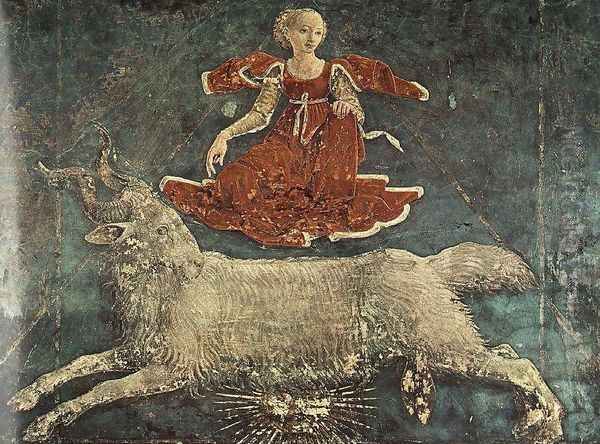
Another key work from his Bolognese period is the Annunciation (c. 1470-1472), now in the Gemäldegalerie Alte Meister, Dresden. This painting is celebrated for its exquisite detail, luminous color, and complex spatial construction. The Virgin Mary and the Archangel Gabriel are placed within an elaborate architectural setting, rendered with meticulous attention to perspective. A particularly intriguing detail is the presence of a small snail in the foreground, a motif whose precise symbolism has been much debated by art historians. Some interpret it as a symbol of the Virgin Birth (as snails were once believed to reproduce asexually), while others see it as a representation of humility, the slow but sure arrival of salvation, or even a touch of "unrealistic consciousness" as one scholar put it, a deliberate insertion of the mundane into the divine.
Cossa also created the Madonna and Child with Two Saints and Portraits of Alberto de' Cattanei and a Member of his Family (also known as the Pala dei Mercanti or Merchants' Altarpiece), painted around 1474 and now in the Pinacoteca Nazionale, Bologna. This work demonstrates his skill in portraiture, capturing the likenesses of the donors with a sober realism, while the sacred figures maintain a dignified monumentality. The composition is balanced, and the interaction between the figures is subtly conveyed.
Beyond panel painting, Cossa also engaged in other artistic endeavors in Bologna. He is known to have designed stained-glass windows, including a notable oculus window depicting the Madonna and Child with an Angel for the church of San Giovanni in Monte (c. 1475-1477). This demonstrates his versatility and his ability to adapt his style to different media. His work in Bologna was highly influential, contributing to the development of the Bolognese school of painting. Artists like Lorenzo Costa, who was Ferrarese by birth but active in Bologna, and later Bolognese masters such as Francesco Francia and Amico Aspertini, would have been aware of Cossa's powerful contributions.
Artistic Style, Techniques, and Influences Revisited
Francesco del Cossa's artistic style is a fascinating amalgamation of various influences, forged into a highly personal idiom. His figures are typically robust and well-defined, with a strong sense of three-dimensionality, often described as "sculptural." This quality likely derives from his study of Donatello's powerful sculptures in Padua and the work of Mantegna. The draperies clothing his figures are a hallmark of his style: complex, often with sharp, angular folds that seem almost metallic or crystalline, yet they effectively reveal the anatomical structure beneath. This treatment of drapery can be seen as a development of the style found in the work of earlier Ferrarese artists and also shows affinities with certain Northern European painters like Rogier van der Weyden, whose works were known in Italy, particularly at the Este court.
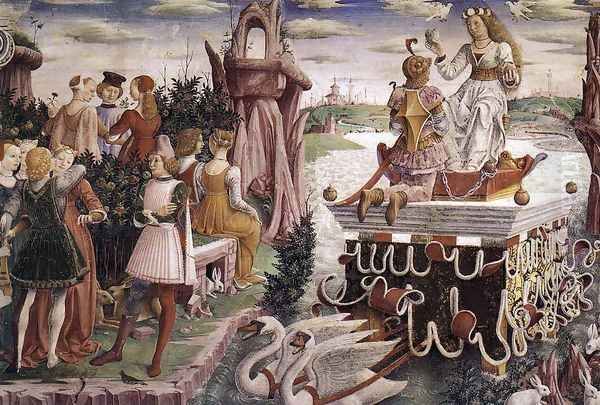
His use of line is incisive and expressive, defining contours with precision and contributing to the overall decorative richness of his surfaces. While his figures possess a certain gravitas, there is often an underlying energy, a sense of contained movement or psychological intensity. This is particularly evident in the expressive faces and gestures of his characters.
Cossa was a master of light and color. His palette is often rich and luminous, with a preference for strong, clear hues. He used light not only to model form but also to create atmosphere and highlight significant details. His understanding of perspective, likely absorbed from Piero della Francesca and Mantegna, allowed him to create convincing and often complex spatial environments for his figures. The architectural settings in his paintings are frequently elaborate and meticulously rendered, demonstrating an interest in classical forms and a sophisticated understanding of spatial recession.
The influence of Northern Renaissance art, particularly in its detailed realism and rich textures, is also discernible in Cossa's work. Ferrara, as a trading center, had connections with Northern Europe, and Este patrons were known to collect Flemish paintings. This exposure may have encouraged Cossa's own meticulous attention to detail, seen in the rendering of fabrics, jewels, and still-life elements. However, he always integrated these details into a larger, harmoniously composed whole, never allowing them to overwhelm the main subject. His work retains a "local Ferrarese ease," a certain lightness and decorative flair that distinguishes it from the more austere monumentality of some of his Florentine or Umbrian contemporaries like Fra Angelico or Perugino.
Contemporaries and the Artistic Milieu
Francesco del Cossa did not work in isolation. He was part of a vibrant artistic community, and his interactions with other artists were crucial to his development and career. In Ferrara, his most important contemporaries were Cosimo Tura (c. 1430 – 1495) and Ercole de' Roberti (c. 1451 – 1496). Together, these three artists are considered the leading figures of the Ferrarese School in the latter half of the 15th century.
Tura, the eldest of the three, was the court painter to Borso d'Este and later Ercole I d'Este. His style is characterized by an intense, almost wiry linearity, highly expressive, sometimes gaunt figures, and a fantastical imagination. While Cossa collaborated with Tura on the Schifanoia frescoes, his own style, as noted, tended towards a greater naturalism and a less strained emotionalism.
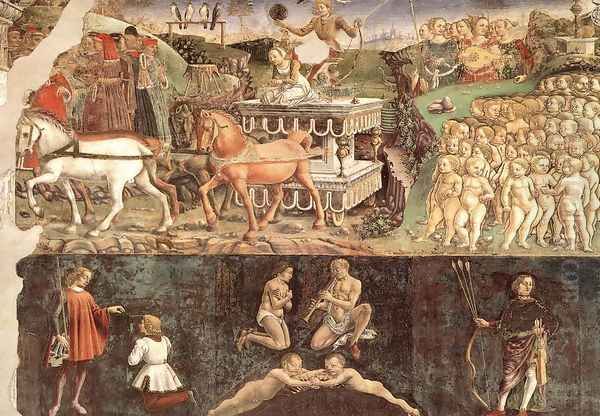
Ercole de' Roberti, younger than Cossa, was perhaps his closest artistic associate, particularly during Cossa's Bolognese period. Roberti's style is marked by its dynamic energy, emotional intensity, and brilliant color. He is believed to have been Cossa's pupil or assistant, and their works sometimes show a strong stylistic affinity. After Cossa's death, Roberti succeeded Tura as court painter in Ferrara. Other Ferrarese painters of the period include Bono da Ferrara, who was influenced by Pisanello and Mantegna, and Antonio Cicognara, known for his miniatures.
In Bologna, Cossa would have encountered a different artistic environment. While Bologna did not have a "school" as cohesive as Ferrara's at this time, it was home to several notable artists. Marco Zoppo, who had trained in Padua under Francesco Squarcione (Mantegna's master), was active in Bologna for a period. His style, like Mantegna's, was characterized by a strong interest in classical antiquity and sculptural forms. Cossa's arrival in Bologna undoubtedly provided a significant stimulus to local painters. His powerful altarpieces and frescoes would have been studied by younger artists, contributing to the city's artistic development. The influence of Venetian art, through artists like Giovanni Bellini and Carlo Crivelli (who also worked in the Marche region, not far from Bologna), was also beginning to be felt in the Emilia-Romagna region. Crivelli, in particular, shared with the Ferrarese a love for intricate detail and decorative richness, though his style was more overtly Gothicizing.
Unresolved Questions and Enduring Legacy
Despite the significant research dedicated to Francesco del Cossa, some aspects of his life and work remain subjects of discussion and mystery. The precise extent of his contributions to the Schifanoia frescoes, beyond the universally accepted months of March, April, and May, is sometimes debated. The full iconography of these frescoes, particularly the enigmatic "decans" in the middle registers, continues to fascinate scholars.
The symbolism of certain elements in his paintings, such as the famous snail in the Dresden Annunciation, remains open to interpretation, adding a layer of intrigue to his work. As mentioned, the exact date of his death is also somewhat uncertain, with most scholars favoring 1477 or 1478, based on documents related to the plague in Bologna. However, some older sources suggested he might have lived until 1485, though this is now generally discounted. The loss of many of his works, including significant portions of the Schifanoia cycle and potentially other commissions, means that our understanding of his oeuvre is inevitably incomplete.
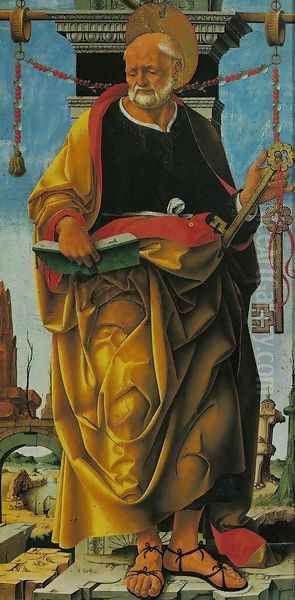
Francesco del Cossa's legacy, however, is undeniable. He was a key figure in establishing the unique character of the Ferrarese School, and his work in Bologna had a lasting impact on the art of that city. His ability to combine monumental grandeur with meticulous detail, spiritual intensity with keen observation of the natural world, and classical learning with a vibrant, personal style, marks him as one of the most original talents of his generation. His influence can be seen in the work of later Ferrarese and Bolognese painters.
In more recent times, Cossa's art has found a new resonance. The British novelist Ali Smith, in her acclaimed novel How to Be Both (2014), imaginatively interweaves the story of a modern-day teenager with a fictionalized account of Francesco del Cossa's life and experiences, particularly focusing on the creation of the Schifanoia frescoes. This has brought the artist and his extraordinary work to the attention of a wider, contemporary audience, highlighting the enduring power of his art to captivate and inspire across centuries.
Conclusion: A Master of Expressive Realism
Francesco del Cossa, though his career spanned little more than two decades, made a profound and lasting contribution to Italian Renaissance art. From his formative years in the culturally rich environment of Ferrara to his mature period in Bologna, he developed a distinctive artistic voice characterized by sculptural solidity, linear dynamism, luminous color, and a remarkable attention to detail. His work on the Palazzo Schifanoia frescoes remains a landmark of Early Renaissance secular decoration, offering a vivid panorama of courtly life, astrological lore, and mythological fancy. His Bolognese altarpieces, such as the Griffoni Altarpiece and the Pala dei Mercanti, demonstrate his mastery of religious themes and his ability to convey deep human emotion and spiritual conviction.
Influenced by giants like Mantegna and Piero della Francesca, yet always retaining his individuality, Cossa forged a style that was both intellectually rigorous and visually compelling. He successfully navigated the demands of powerful patrons like Borso d'Este while striving for artistic recognition and fair compensation. His legacy lies not only in the magnificent artworks he left behind but also in his role as a key progenitor of the Ferrarese School and a significant influence on Bolognese painting. Francesco del Cossa remains a testament to the artistic vitality and regional diversity of the Italian Renaissance, a master whose works continue to engage and reward close study. His art, with its blend of robust realism and poetic imagination, secures his place among the most important painters of the Quattrocento.